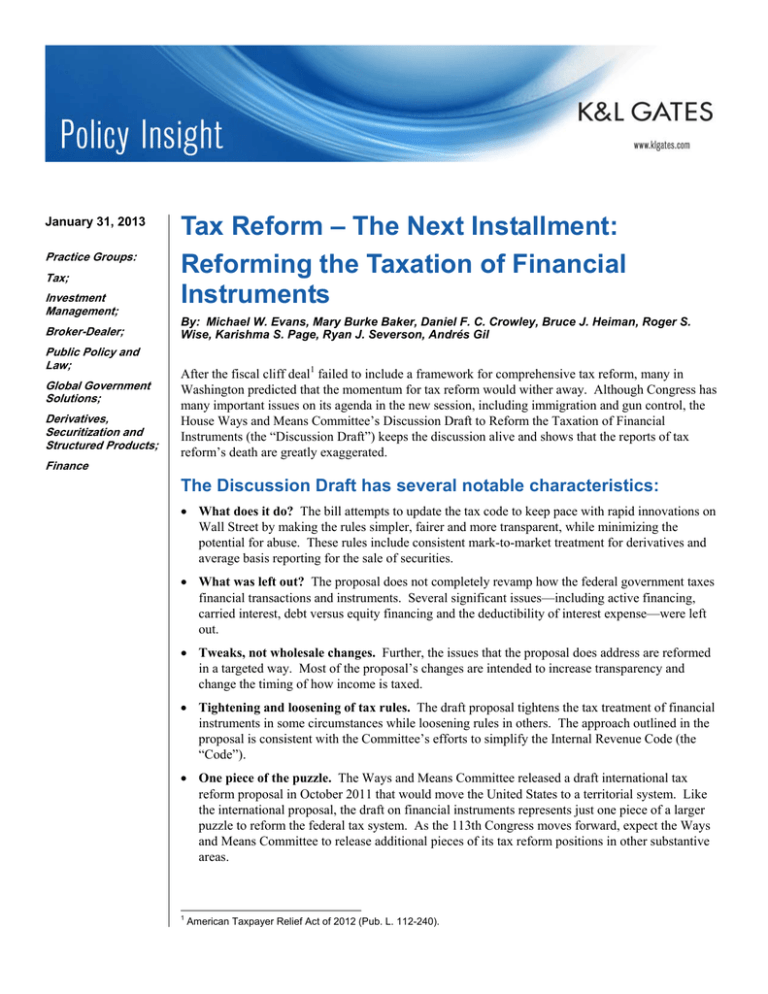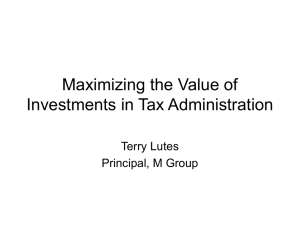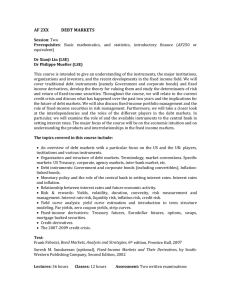
January 31, 2013
Practice Groups:
Tax;
Investment
Management;
Broker-Dealer;
Public Policy and
Law;
Global Government
Solutions;
Derivatives,
Securitization and
Structured Products;
Tax Reform – The Next Installment:
Reforming the Taxation of Financial
Instruments
By: Michael W. Evans, Mary Burke Baker, Daniel F. C. Crowley, Bruce J. Heiman, Roger S.
Wise, Karishma S. Page, Ryan J. Severson, Andrés Gil
After the fiscal cliff deal1 failed to include a framework for comprehensive tax reform, many in
Washington predicted that the momentum for tax reform would wither away. Although Congress has
many important issues on its agenda in the new session, including immigration and gun control, the
House Ways and Means Committee’s Discussion Draft to Reform the Taxation of Financial
Instruments (the “Discussion Draft”) keeps the discussion alive and shows that the reports of tax
reform’s death are greatly exaggerated.
Finance
The Discussion Draft has several notable characteristics:
What does it do? The bill attempts to update the tax code to keep pace with rapid innovations on
Wall Street by making the rules simpler, fairer and more transparent, while minimizing the
potential for abuse. These rules include consistent mark-to-market treatment for derivatives and
average basis reporting for the sale of securities.
What was left out? The proposal does not completely revamp how the federal government taxes
financial transactions and instruments. Several significant issues—including active financing,
carried interest, debt versus equity financing and the deductibility of interest expense—were left
out.
Tweaks, not wholesale changes. Further, the issues that the proposal does address are reformed
in a targeted way. Most of the proposal’s changes are intended to increase transparency and
change the timing of how income is taxed.
Tightening and loosening of tax rules. The draft proposal tightens the tax treatment of financial
instruments in some circumstances while loosening rules in others. The approach outlined in the
proposal is consistent with the Committee’s efforts to simplify the Internal Revenue Code (the
“Code”).
One piece of the puzzle. The Ways and Means Committee released a draft international tax
reform proposal in October 2011 that would move the United States to a territorial system. Like
the international proposal, the draft on financial instruments represents just one piece of a larger
puzzle to reform the federal tax system. As the 113th Congress moves forward, expect the Ways
and Means Committee to release additional pieces of its tax reform positions in other substantive
areas.
1
American Taxpayer Relief Act of 2012 (Pub. L. 112-240).
Tax Reform – The Next Installment:
Reforming the Taxation of Financial Instruments
Feedback is welcome, but act fast. The Ways and Means Committee is soliciting feedback on
the draft proposal from stakeholders. Although there is no official deadline for comments, the time
frame for tax reform to begin moving is uncertain, so those interested in the proposal should act
quickly to ensure that their voices are heard.
Momentum continues to build. The draft proposal represents the latest stage in an ongoing effort
by the congressional tax writing committees to pursue comprehensive tax reform. The Discussion
Draft appears to be a House Republican proposal, rather than a bipartisan or bicameral product.
However, Ways and Means Ranking Member Sander Levin (D-MI) appears to support the
Discussion Draft as part of a strategy of raising revenues and closing loopholes to reduce the
federal deficit.
If enacted into law, the proposals in the Discussion Draft would be effective for transactions entered
into after December 31, 2013.
A few of the proposals, such as the hedging identification proposal, would benefit taxpayers.
However, many of the proposals represent significant shifts from current policy that could adversely
affect financial institutions, operating companies, and individuals. Those proposals would force
reconsideration of current investment strategies. Below is a summary of the Discussion Draft’s
proposals and impact.
1. Provide Uniform Tax Treatment of Financial Derivatives
The taxation of derivatives has not kept pace with the increasing complexity of new financial
instruments, such as swaps, and results in inconsistencies in the timing for recognition of gain or loss
and the character of that gain or loss. For example, the Discussion Draft notes that the Code requires
recognition of gain upon disposition or settlement of some financial derivatives, such as options and
forwards, while other financial derivatives, known as Section 1256 contracts (including regulated
futures contracts and foreign currency contracts), require that the taxpayer mark to market any gain or
loss as of the last day of the taxable year. Any gain or loss on a Section 1256 contract is recognized
60 percent as long-term capital gain or loss and 40 percent as short-term capital gain or loss.
The Discussion Draft dramatically changes the taxation of financial derivatives for most taxpayers and
repeals several existing applicable code sections, such as Section 1256. In general, the proposal calls
for any gain or loss from all types of derivatives to be reported on an annual basis under a mark-tomarket rule, and all gain or loss due to mark-to-market reporting would be treated as ordinary income.
The Discussion Draft also expands the definition of derivative to include options, forwards, futures,
and swaps. Moreover, the proposal would apply equally to privately held and publicly traded
derivatives. Derivatives relating to real estate or entered into as part of a hedging transaction would
be exempt from these special rules.
This proposal would significantly impact the attractiveness of investments in derivatives. Requiring
recognition of gain or loss on options each year is a dramatic shift from current rules that tie
recognition of gain or loss to the exercise or maturity of an option. Character mismatches will occur
in several situations, such as when a share of stock underlying an option is sold for a capital gain or
loss. Further, mark-to-market treatment is not currently required for many financial instruments, such
as credit default swaps or interest rate swaps, meaning that financial institutions and investors using
these instruments would need to assess the impact of recognizing gain or loss as ordinary income on a
yearly basis on their return on investment.
There are also valuation and cash flow challenges associated with the mark-to-market rule. Many
derivatives are multiyear obligations that fluctuate in value and do not provide an economic benefit to
2
Tax Reform – The Next Installment:
Reforming the Taxation of Financial Instruments
its holder before it is exercised. In certain situations, a taxpayer could be forced to recognize gain in
one year when a derivative instrument ultimately resulted in loss upon expiration in the subsequent
year. Additionally, illiquid and unique derivatives may be difficult to value on a year-to-year basis.
It is also important to note that the new higher ordinary income tax rate of 39.6 percent enacted in the
American Taxpayer Relief Act would apply to yearly recognition of mark-to-market gain under the
proposal. For certain taxpayers, the new 3.8% tax on unearned investment income that took effect on
January 1, 2013 would also apply. If ordinary income and capital gains rates are reopened as part of a
comprehensive tax reform debate, the derivatives proposal would need to be considered in light of any
changes that are made to the rates.
2. Simplify Business Hedging Tax Rules
In a related proposal, the Discussion Draft proposes a new and easier method of allowing taxpayers to
report their hedging transactions. Under Section 1221, taxpayers are required to identify the item or
aggregate risk being hedged on the same day that a taxpayer acquires, originates, or enters into a
hedging transaction. Relevant accounting rules under U.S. Generally Accepted Accounting Principles
(“GAAP”) require similar disclosure of hedging transactions, but such disclosure does not satisfy
Section 1221 requirements unless the disclosure is identified as a hedging transaction for tax purposes.
The Discussion Draft’s proposal addresses “foot faults” and inadvertent failures to properly and timely
identify hedging transactions under Section 1221. The proposal would allow a taxpayer to meet the
requirements of Section 1221 either by meeting the identification requirements of existing law or
identifying the hedging transaction per GAAP in the taxpayer’s audited and certified financial
statements.
Importantly, the proposal does not affect the definition of a hedging transaction under the Code.
Similarly, the proposal does not impact the relevant accounting standards under GAAP.
3. Eliminate “Phantom” Tax Resulting from Debt Restructurings
– Cancellation of Debt Income
Generally, the Code provides that cancellation of indebtedness is includible in gross income. When
debt is restructured, cancellation of debt (“COD”) income may be triggered as a result of an exchange
of one debt obligation for a new debt obligation or as a result of a modification of an existing debt
obligation. These rules generally provide that a holder of debt must recognize gain or loss to the
extent that the “issue price” of a new obligation (e.g., its fair market value) differs from the original
debt.
Prior to 1990, debt restructurings that did not involve the forgiveness of principal were protected from
potential COD income. The rule provided that the issue price of a new debt instrument could not be
less than the adjusted issue price of the old debt instrument, which meant that there would be no COD
income after restructuring debt (absent forgiveness of principal). This rule was repealed as part of the
Omnibus Budget Reconciliation Act of 1990.
The Discussion Draft proposes reinstating the special COD rule for debt restructurings as a result of a
“specified debt modification.” A specified debt modification includes (1) an exchange by the debt
holder of a new debt instrument for the existing debt instrument and (2) the amendment of an existing
debt instrument, including a “significant modification” such as a change in timing for payments that
results in a material deferral of scheduled payments. The new COD rule will provide particular relief
3
Tax Reform – The Next Installment:
Reforming the Taxation of Financial Instruments
for borrowers who seek to restructure their debt obligations, including mortgages, as a result of
changing economic circumstances.
4. Harmonize the Tax Treatment of Bonds Traded at a Discount
or Premium on the Secondary Market
A taxpayer who purchases a bond at a discount (i.e., less than the amount to be repaid) generally must
include the value of the discount as ordinary interest income. The inclusion of the discount as interest
income can differ depending on whether a bond was acquired directly from an issuer or on a
secondary market. If a bond is purchased directly from a purchaser, the purchaser is required to
include the discount in taxable income as additional interest over the life of the bond. However, if a
bond is purchased on a secondary market, a purchaser has the option of including the discount in
taxable income as additional interest when the bond is retired or the purchaser resells the bond. Thus,
the timing of taxable interest varies significantly depending on whether a bond is purchased directly
from an issuer or on the secondary market.
The Ways and Means proposal would align the treatment of taxable interest income of bonds
purchased directly from an issuer and bonds purchased on a secondary market. Purchasers of bonds
on a secondary market would be required to report as interest income the sum of the daily portion of
market discount for each day that the purchaser holds the bond, rather than having the choice of
including that taxable interest in income when the bond was retired or sold. However, the amount of
taxable interest would be limited to the greater of (1) the bond’s original yield plus five percentage
points or (2) the applicable federal rate for the bond at the time the bond was acquired, plus ten
percentage points. These limits reflect the intent to limit taxable interest income only to the extent
that interest rates have increased since a bond was originally issued.
Additionally, the Ways and Means proposal would revise the treatment of bonds acquired at a
premium (i.e., for more than the amount to be repaid). Currently, a holder of a bond is entitled to a
deduction of the premium on an amortized basis, but only after calculation of a taxpayer’s adjusted
gross income. The Ways and Means proposal allows a deduction for a bond premium “above the
line,” which would reduce adjusted gross income.
5. Rules Regarding Certain Government Debt
As discussed above, if the value of a bond declines after it is originally issued, the purchaser acquires
it with a market discount. The Code treats the discount on certain short-term government obligations
disparately, depending on the taxpayer. Specifically, a cash-basis taxpayer holding a non-interest
bearing obligation may elect to include in income the increase in the value of the obligation when the
obligation is paid at maturity or otherwise. In contrast, taxpayers using the accrual method of
accounting must include the discount in current income.
The Discussion Draft harmonizes the tax treatment of such discounts, repealing the rule that taxpayers
using the accrual method must report the discount in current income. As a result, all taxpayers have
the flexibility to elect the most advantageous tax treatment.
Additionally, the Code generally requires that any increase in the value of a U.S. savings bond is
includible in gross income in the taxable year that the bond is redeemed or at final maturity,
whichever is earlier. The Code also allows taxpayers to exchange certain obligations without
recognition of gain or loss, including individuals exchanging Series E or EE savings bonds for Series
H or HH savings bonds. The Discussion Draft repeals the provision allowing for tax-free exchange of
such bonds, as the Treasury no longer issues Series H or HH savings bonds.
4
Tax Reform – The Next Installment:
Reforming the Taxation of Financial Instruments
6. Require Basis Reporting in Sales of Securities
Generally, the Code provides that if a taxpayer has purchased substantially identical securities at
different times and different prices, shares subsequently sold or transferred are deemed to be the
earliest acquired securities (first-in-first-out rule or “FIFO”) and have the basis of such securities.
However, a taxpayer has the ability to make a “specific identification,” allowing the taxpayer to
identify specific securities and use the basis of those particular securities. In so doing, a taxpayer who
has purchased substantially identical securities at different times and prices can control the taxable
gain or loss by choosing the basis of shares later sold. The rules were modified in 2008 for taxpayers
who hold shares in a Regulated Investment Company (“RIC”). The RIC rules permit a taxpayer to
elect, in lieu of FIFO or specific identification, an average basis method on an account-by-account
basis, calculated to reflect the taxpayer’s average basis in the securities held in an account, including
any securities sold and retained during the year.
The Discussion Draft significantly expands the 2008 rule by requiring that the cost of any specified
security disposed of on or after January 1, 2014 be determined in accordance with the average basis
method. Unlike the RIC rules, which are permissive and allow the taxpayer to elect the average basis
method, the Discussion Draft mandates the use of the average basis method for the sale of all
securities. The proposal contains transition relief, treating any specified security acquired before the
effective date as in a separate account and allowing the taxpayer to determine the basis of such
securities using a previously acceptable method.
Additionally, a broker is currently required to report a customer’s adjusted basis in a covered security
that the customer has sold. The Discussion Draft requires that brokers use the average basis method in
satisfying their basis reporting requirements.
Although the proposal reduces complexity for taxpayers in determining the gain or loss associated
with the disposition of securities, the provision significantly reduces the ability of taxpayers to control
such gain or loss by strictly prescribing how the basis must be calculated.
7. Limit Harvesting of Tax Losses on Securities
The Code contains so-called “wash sale” rules, preventing a taxpayer from immediately deducting
losses from the disposition of securities if substantially similar securities are acquired by the taxpayer
during the period 30 days before to 30 days after the sale. Under the rules, any such loss is deferred
until the replacement securities are later sold.
Taxpayers have attempted to work around the wash sale rules by using a closely related party to
acquire the replacement securities. Consequently, the IRS has issued guidance that if a taxpayer sells
securities, and the taxpayer’s spouse or controlled corporation buys substantially identical securities,
the transaction constitutes a wash sale.
The Discussion Draft expands the wash sale rule, codifying the IRS guidance. For purposes of the
proposal, a related party is defined broadly, including the taxpayer’s spouse, dependents, individuals
of whom the taxpayer is a dependent, and certain related individual, corporate, partnership, trust,
estate, and investment or savings arrangements of or controlled by such individuals. Moreover, the
Discussion Draft provides Treasury with the regulatory authority to prevent the avoidance of the wash
sale rules, including adding additional related parties.
5
Tax Reform – The Next Installment:
Reforming the Taxation of Financial Instruments
Next Steps
The Ways and Means Committee has requested comments and feedback regarding the Discussion
Draft. As with the release of the international tax reform proposal in October 2011, we can expect that
hearings will be scheduled to examine the costs and benefits of the proposal, and to assess the scope
and impact on investors, financial institutions and the U.S. capital markets.
Moving forward, the path and timing for tax reform is uncertain. Congressional leaders on both sides
of the aisle, along with President Obama, have called for an overhaul of the Code in recent weeks.
The upcoming fiscal challenges facing Congress, including the debt ceiling, sequestration, and the
federal budget, provide possible vehicles to pass a framework for tax reform. Such a framework could
set revenue goals, targeted tax rates, and establish an expedited process for considering tax reform
legislation later this year. However, tax reform discussions could occur even if a framework and a
process are not included in upcoming legislation, although dealing with tax reform through regular
order could take longer. Regardless of this uncertainty, the Ways and Means Discussion Draft shows
that the tax reform debate is moving past discussions of high-level principles and towards specific
policy proposals.
Given the accelerating pace of tax reform in the 113th Congress, we encourage you to weigh in on the
merits and costs of the Discussion Draft. Concerned individuals, corporations, and financial
institutions should take note that this is an early opportunity to engage with Congress on the shape of
comprehensive tax reform.
6
Tax Reform – The Next Installment:
Reforming the Taxation of Financial Instruments
Authors:
Michael W. Evans
Bruce J. Heiman
Ryan J. Severson
michael.evans@klgates.com
+1.202.661.3807
bruce.heiman@klgates.com
+1.202.661.3935
ryan.severson@klgates.com
+1.202.778.9251
Mary Burke Baker
Roger S. Wise
Andrés Gil
mary.baker@klgates.com
+1.202.778.9223
roger.wise@klgates.com
+1.202.778.9023
andres.gil@klgates.com
+1.202.778.9226
Daniel F. C. Crowley
Karishma S. Page
dan.crowley@klgates.com
+1.202.778.9447
karishma.page@klgates.com
+1.202.778.9128
Anchorage Austin Beijing Berlin Boston Brisbane Brussels Charleston Charlotte Chicago Dallas Doha Dubai Fort Worth Frankfurt
Harrisburg Hong Kong London Los Angeles Melbourne Miami Milan Moscow Newark New York Orange County Palo Alto Paris Perth
Pittsburgh Portland Raleigh Research Triangle Park San Diego San Francisco São Paulo Seattle Seoul Shanghai Singapore Spokane
Sydney Taipei Tokyo Warsaw Washington, D.C.
K&L Gates practices out of 46 fully integrated offices located in the United States, Asia, Australia, Europe, the
Middle East and South America and represents leading global corporations, growth and middle-market companies,
capital markets participants and entrepreneurs in every major industry group as well as public sector entities,
educational institutions, philanthropic organizations and individuals. For more information about K&L Gates or its
locations, practices and registrations, visit www.klgates.com
This publication is for informational purposes and does not contain or convey legal advice. The information herein should not be used or relied upon in
regard to any particular facts or circumstances without first consulting a lawyer.
©2013 K&L Gates LLP. All Rights Reserved.
7





